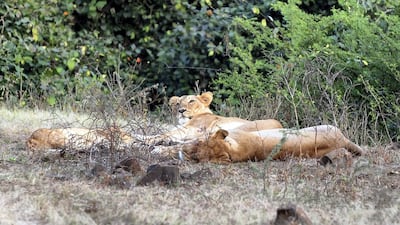In Gujarat’s Gir Forest Reserve, the last home of the Asiatic lion, the big cats have been falling into open wells, running into electrified fences, getting hit by trains, and dying in other unnatural ways.
The deaths are, in an odd way, a measure of Gir’s success at conserving the lion.
The numbers have risen to such an extent that more and more lions are venturing outside the reserve’s protected areas. Nevertheless, Gujarat has set about trying to find a way to minimise these unnecessary deaths.
Last year, a census in Gir counted 650 lions - an increase from the 523 counted in 2015. But in that same two-year span, 184 lions died - 32 of them of unnatural causes - according to Gujarat government figures that were compiled and released last month.
The figures were worrying enough that the state’s high court took notice and asked Hemang Shah, an Ahmedabad-based lawyer, to file a public-interest petition to push the government for action.
The Gir reserve, set up in 1965, sprawls across 1,153 square kilometres in one of the Asiatic lion’s natural habitats. The population of lions in that area had declined alarmingly; just 18 were counted in this region in 1893, and the numbers dwindled elsewhere in India as well.
After Gir was established, the tally began inching upwards: 284 in 1994, 359 in 2005, 411 in 2010. “The story of the Asiatic lion is actually a wonderful success story in conservation,” Ravi Chellam, a conservation scientist who has studied Gir’s lions, said. “Even given that, success has to be managed properly for it to be sustained over the long term.”
Gir’s protected areas can cope with a maximum population of 260-300 lions. Roughly half of the present population lives, or spends most of its time, outside the reserve’s core protected area.
The 32 lions that died of unnatural causes all died in the reserve’s periphery, where the protected areas bleed into human settlements. “So there are electric fences protecting farmers’ fields, or there are roads and train tracks, or there are big open wells,” Mr Shah said. “These are the four ways in which lions are dying.”
_______________
Read more:
Iran moves to save last Asiatic cheetahs
Lions of Kandahar give pride back to Kabul zoo
Oman wildlife rangers losing the battle to poaching and housing estates
_______________
Solving these problems wasn’t always straightforward, Mr Shah said. For instance, a government proposal to fence off the train tracks will only curtail the lions’ natural movements. “They have a particular territory in which they hunt, and you can’t cut them off from that.”
Similarly, farmers concerned for their livestock choose electrified fences to most effectively protect their animals from lion attacks.
In his petition, filed on March 21, Mr Shah lays out some suggestions, though. “You can lower the speeds of trains in this area, for a start,” he said. “The roads passing through are open all day, but maybe they can be closed off at night, because you have all these cars and trucks just zooming through when lions and cubs are on the move.”
The state was also supposed to construct parapets around open wells. A World Wildlife Fund report said that 187 such parapets had been constructed so far. "But either these parapets are broken, or they've been built only on paper, or there are newly excavated wells out there," Mr Shah said. "Because we still find lions dying by falling into wells."
Conservation scientist Mr Chellam pointed to a parallel problem. In 2013, he said, India’s Supreme Court had ruled that a number of Gir’s lions should be moved, within six months, to a new reserve in the state of Madhya Pradesh.
“The translocation was to reduce the risks associated with all-your-eggs-in-one-basket syndrome,” Mr Chellam said. If an epidemic were to strike Gir, for instance, it would endanger the only population of lions in the country.
“But even after the court’s order, things have moved very slowly. The entire translocation project seems to be in limbo,” he explained. “The project would have been relevant even if there were 50 lions in Gir. It’s all the more relevant when there are between 600 and 700 lions there now.”
Irrespective of the number, Mr Chellam said, some animals will always wander outside Gir’s protected areas, and it would be impossible to segregate them from human-inhabited regions entirely.
“It’s unreasonable to ask the local people, who are usually poor in these areas, to put their lives on hold - to not have roads or to not protect their farm animals,” he said.
“But certainly traffic can be regulated, and the speeds of trains can be regulated,” Mr Chellam said. “It boils down to how people behave.”

